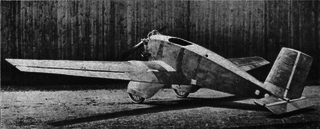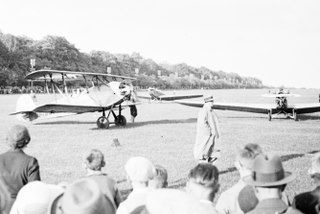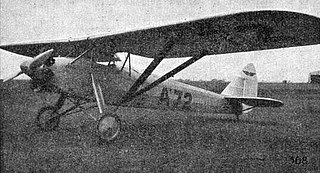
The Focke-Wulf Fw 44 Stieglitz ("Goldfinch") is a 1930s German two-seat biplane. An early design by Kurt Tank, it was produced by the Focke-Wulf company as a pilot training and sports flying aircraft. It was also eventually built under license in several other countries.

The Messerschmitt Bf 108 Taifun was a German single-engine sport and touring aircraft, developed by Bayerische Flugzeugwerke in the 1930s. The Bf 108 was of all-metal construction.

The Dornier Do 11 was a German heavy bomber, developed in secret in the early 1930s. It was originally called the Dornier F before being renamed by the Reichsluftfahrtministerium (RLM) in 1933, and was considered a heavy bomber at the time. It came into service in 1932, a continuation of a line of bomber designs from the Dornier Do P in 1930, and the Dornier Do Y in 1931. The line would continue to develop with the Dornier Do 13 and Dornier Do 23.

The Heinkel He 72 Kadett ("Cadet") was a German single-engine biplane trainer of the 1930s.

The Albatros L 59 was a single-seat German utility aircraft of the 1920s. It was a single-engine low-wing cantilever monoplane with large, spatted wide track undercarriage attached, unusually for the time not to the fuselage but to the wing roots. The whole aircraft was covered in 3-ply.

The Ambrosini SAI.10 Grifone ("Griffon") was a military trainer aircraft produced in small numbers for the Italian Regia Aeronautica early in World War II. With the approach of war, the Ministero dell' Aeronautica began a programme to increase the number of pilots available, and ordered a prototype primary trainer from Ambrosini. This aircraft, a parasol monoplane of mixed construction, first flew on July 8, 1939, with Guiliano Ferrari at the controls. A production batch of 50 was ordered, but this was quickly reduced to just 10 machines, all of which were delivered in 1940.
The Arado V.1 was a prototype airliner, built in Germany in 1927. It was a single-engine, high-wing braced monoplane with tailwheel undercarriage. It made several long-distance flights, including carrying mail to South America, before being exhibited in Berlin in 1929, when it was bought by Deutsche Luft Hansa.
The Arado W 2 was a two-seat twin-engine seaplane trainer developed for the DVS in 1928. It was a cantilever monoplane with a fabric-covered steel tube fuselage that accommodated the pilot and instructor in tandem open cockpits. The undercarriage consisted of two pontoons carried on steel struts.

The Pfalz D.VIII was a German World War I fighter aircraft.

The Dornier Libelle, also designated Do A, was a German open-cockpit, all-metal, parasol wing, monoplane flying boat aircraft, with partly fabric-covered wings. A landplane version, built without sponsons and fitted with a fixed tailwheel undercarriage was produced as the Dornier Spatz.

The Focke-Wulf S 2 was a trainer aircraft built in Germany in the late 1920s. It was a conventional parasol-wing monoplane with fixed tailskid undercarriage. The pilot and instructor sat side by side in an open cockpit. Only a single example was built.

The Focke-Wulf S 24 Kiebitz was a sport aircraft built in Germany in the later 1920s. It was a single-bay biplane of conventional design with equal-span, unstaggered wings, braced with N-type interplane struts. The pilot and a single passenger sat in tandem open cockpits, and it was fitted with a fixed tailskid undercarriage. The wings could be folded for transportation or storage, and the aircraft was designed to be towed by a car.

The Fokker S.IV was a military trainer aircraft produced in the Netherlands in the mid-1920s. It was a conventional, single-bay biplane with staggered wings of unequal span braced with N-struts, essentially a radial-engined development of the S.III. The pilot and instructor sat in tandem, open cockpits and the undercarriage was of fixed, tailskid type with a cross-axle between the main units. The Royal Netherlands Army Aviation Group purchased 30 examples and used them right up to the German invasion of the Netherlands in 1940. On 14 May that year, a few surviving S.IVs escaped to France alongside some S.IX trainers, but never flew again.

The Hopfner HS-8/29 was a utility aircraft built in Austria in the late 1920s based on the Hopfner HS-5/28. It used a modernised version of its predecessor's airframe, being a conventional, parasol-wing monoplane with seating for two occupants in tandem, open cockpits. The landing gear was of fixed, tailskid type with divided main units. The first prototype used the same Walter NZ 85 engine that the later HS-5/28s had used, but this was followed by 14 production examples with Siemens engines, and a single prototype with a de Havilland Gipsy III.

The Bayerische Flugzeugwerke M 18, was an airliner, produced in Germany in the late 1920s.
The Arado Ar 69 was a two-seat German beginner's school and sport biplane with an open cockpit, developed in 1933 by Arado Flugzeugwerke.
The Udet U 11 Kondor was a German four-engined airliner designed and built by Udet Flugzeugbau, only one was built.
The SIM-VIII was a 1931 Yugoslav, single-engined, 2-seat, sport, tourist and training aircraft, designed by Sima Milutinović and built at the Rogožarski factory in Belgrade from 1931 and by Ikarus at Zemun from 1933.

The Raab-Katzenstein KL.1 Schwalbe (Swallow) was a German two-seat biplane produced in the 1920s. About fifty were built and the type became well known as an aerobatic aircraft, performing at many displays in the hands of pilots like Gerhard Fieseler.
The Pfalz Dr.II was a German triplane fighter prototype of World War I built by Pfalz Flugzeugwerke.















